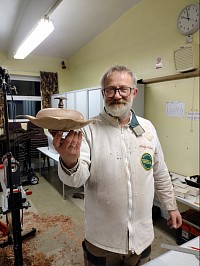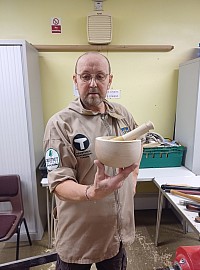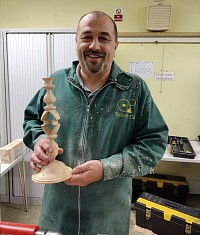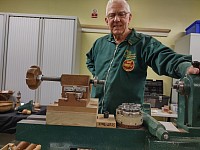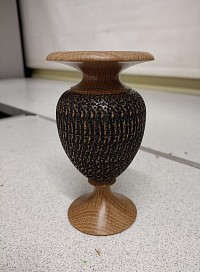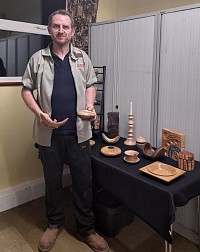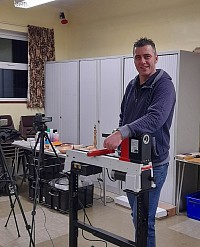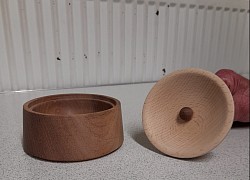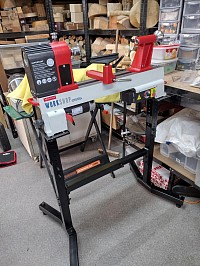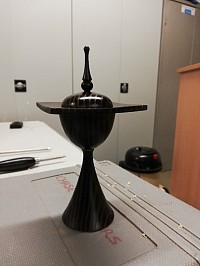Journal of Recent Meetings or Annoucements
Steve Heeley
For April's demo Steve Heeley returned and showed how to create an acorn box. Steve showed how to define the shape, hollow the box and then give tips to ensure the lid would fit. Notably, Steve suggested leaving the foot on the shape and taking the (almost complete) project into the house to stabilize with the warmer/dryer environment than the average workshop. Once the project has had an opportunity to dry out (and move), it can then be returned to the lathe for final fitting of the lid.
Mick Hanbury
For March's demo, the club was pleased to welcome back Mick Hanbury. Mick carried out 2 projects: A shield (embellished with iridescent paints and upholstery pins) and a bowl. Mick walked the members through the processes of both projects, showing how so create the desired shapes, the importance of sharp tools and how incredibly effective effects can be created by simply using your finger to draw in the wet paint.
Wolfgang Schulze Zachau
In February, the club was pleased to welcome Britian's Best Woodworker finalist, Wolfgang Schulze Zachau. The project he produced was an oriental box, with a square base, round lid and decorative finial. While walking us through the process, Wolfgang talked about some of the equipment he was using, explained his approach for taking certain cuts and gave an insight into his switch to becoming a professional woodturner.
Steve Heeley
Rounding off the year, the club welcomed back Steve Heeley for another of his excellent demos. This time, Steve turned a pestle and mortar from ash and boxwood. This is an interesting project for new and experienced turners alike, because it involves both faceplate (the mortar) and spindle (the pestle) turning. Steve talked about how to achieve the correct sweeping action to remove wood efficiently, create a smooth curve on both the inside & outside of the mortar and create a pleasing and functional shape. He also touched briefly on wood toxicity (don't try to make one in Yew!)
Rob Till
Standing in for us in November was Rob Till. Rob showed that you don't need to spend a fortune on expensive exotic woods to produce great pieces of work. Using laminated pieces of Redwood Timber from Wickes, Rob created a stunning candlestick, that combined elements of inside out turning with classical shapes and form. Rob explained the technique for creating the paper joints for the first stage and (with the help of some Blue Peter style items that had been made earlier), took the members through the whole process from start to finish.
Alan Edwards
Alan took members through the process of thread chasing. He gave a demonstration of how to chase by hand, an overview of hobbyist thread chasing kits and rounded out the evening with a fascinating talk about his home made kit and how it works. Such was the interest in this piece, he has kindly agreed to bring it along to October's Hands On evening, so people can have another chance to see it in action.
Mike Taylor
Mike (leaving his pole lathe behind and working on an electric one) gave a great talk about seasoning wood and taking part finished pieces to conclusion. Mike also gave some handy tips on how to minimise cracking as the piece dries and how to prepare and store any wood that you are not planning to turn immediately.
Steve Heeley
This month
saw an excellent demonstration from long time friend of the club, Steve Heeley. Steve produced a textured piece (see image) and talked at length about shape & form and how, with practice, one can find the correct balance of proportions without getting caught up, constantly referring to calipers to find the golden ratio. Steve went on to add colour to the piece in order to make the texture stand out.
Rick Dobney
For April's club meeting, we were pleased to welcome back Rick Dobney, who gave a demonstration of the process of turning a 3x6" blank into an impressive hollow form, without the need for any specialist hollowing tools. The process involved creating the shape, parting through the middle of the blank, adding a mortice and tenon to each half and then (in effect) treating each half as a bowl blank, before using the mortice and tenon to re-join the pieces back together. Rick then followed this up by showing the process of creating a natural edge bowl from a log.
Richard Findley
Richard demonstrated how to make a lided box with a finial and drop finial inside the lid (see images below). The box and finial were turned from sepele whilst the lid was turned from beech. During the demonstration he showed us how to better use our tools whilst turning the pot and gave an excellent explanation of the paradox of cutting down hill
New Club Lathe
A new lathe and stand has been purchased for the club from Axminster tools - an Axminster 305 (see image) - to replace the current club lathe. The lathe will be presented to the club at the earliest opportunity and will be available at the first hands on session of this year.
Club AGM
January was the club AGM, followed by a sharpening workshop. Alan Edwards brought 3 separate jigs, to show the different ways of sharpening a gouge on a bench grinder and members were encouraged to have a go and see which they liked best.
Steve Heeley
Steve Heeley returned in December to show how to create a lidded, stemmed form with a square edge. Steve hollowed out the centre with a spindle gouge, explaining the techniquie as he did so. When a dark colour is applied to a shape, there is nowhere to hide if the silhouette is not perfect, but Steve is a master at creating pleasing shapes and, once again, did not disappoint.
